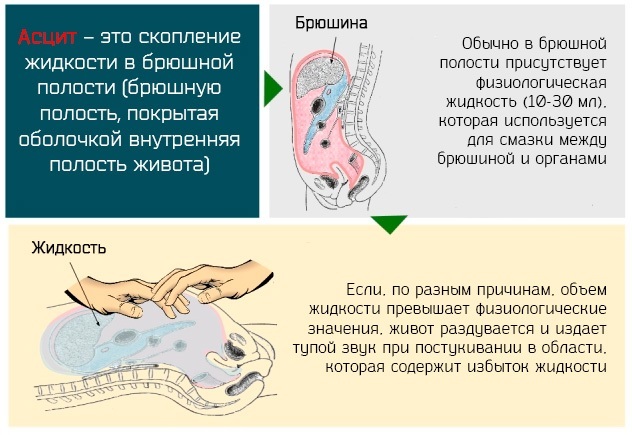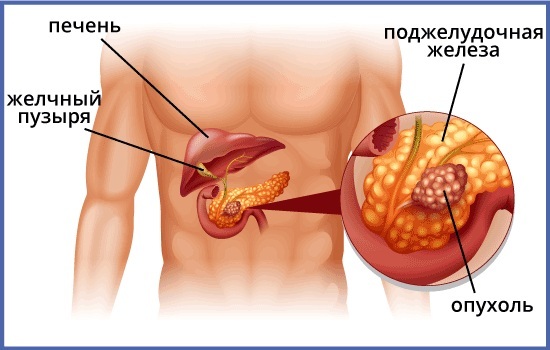Carcinomatosis the abdominal cavity is a serious disease the human body, which is characterized by a pathological state of the entire peritoneum and tissues of internal organs.
This ailment is a complication of an existing cancer, the metastases of which have gone beyond its main site of localization. The migration of malignant cells into the abdominal cavity is carried out together with the flow of the bloodstream, as well as the lymphatic fluid.
In medical practice, this disease is also found under the term "peritoneal carcinomatosis". Treatment of this disease involves the use of chemotherapy drugs, as well as an effective fight against malignant neoplasm.
Record content:
-
1 Stages and degrees
- 1.1 initial stage
- 1.2 Active growth stage
- 1.3 Stage of complete damage to the abdominal cavity
- 2 Symptoms and Signs
- 3 Causes
- 4 Diagnostics
-
5 Treatment methods
- 5.1 Chemotherapy
- 5.2 Abdominal drainage
- 5.3 Cytoreductive surgery
- 5.4 Therapy with cytostatic drugs
- 6 Possible consequences and complications
- 7 Video about carcinomatosis
Stages and degrees
Abdominal carcinomatosis is characterized by gradual and phased development. In this regard, the treatment of this disease should begin at the earliest possible stages, when the onset of severe complications and violations of the functional activity of internal organs.
Carcinomatosis is a secondary pathology, the progression of which directly depends on the dynamics of the tumor process. In this regard, there are several stages of this disease.
initial stage
At the first stage of the development of carcinomatosis, the migration of tumor cells from the focus of malignant neoplasm to the tissues of the abdominal cavity occurs. The spread of metastases occurs in connection with the achievement of the oncological process 3-4 stages of its development, damage to the blood vessels of the tumor as a result of surgical intervention.
The degenerated cells trapped inside the abdominal cavity form multiple areas with signs of an altered structure of epithelial tissues.
In fact, the process of spreading a large number of small tumor bodies is triggered, which can be localized in any part of the peritoneum. At the initial stage, metastases most often affect the greater omentum, Douglas pockets, and the cecum.
Active growth stage
The next stage in the development of carcinomatosis is the active interaction of the degenerated cells with the mesothelium of the abdominal cavity. Metastases are fixed in tissues of this type, and also continue to spread over the entire surface of the peritoneum.
There is an invasive penetration of cancerous tumors with their active growth into the connective tissue of the peritoneum, as well as the basement membrane. At this stage of development of abdominal carcinomatosis, there is still a chance for the success of the therapeutic process, but subject to the simultaneous treatment of primary oncology.
Stage of complete damage to the abdominal cavity
This stage of carcinomatosis is characterized by the formation of a large number of secondary malignant neoplasms that affect certain areas of the abdominal cavity. This stage in the development of the disease is characterized by severe symptoms and an increasing inflammatory process, covering the pleural lobes of the peritoneum.
At this stage of carcinomatosis, the prognosis for patient survival is poor. Most patients with signs of complete damage to the abdominal cavity are in a supine state, move with difficulty and with the help of strangers, and also need to take painkillers regularly funds.
Symptoms and Signs
Carcinomatosis of the abdominal cavity (treatment of this pathology occurs simultaneously with the therapy of cancer) has various forms of its manifestation. The clinical picture of this disease depends on the dynamics of the development of the tumor process.
In most patients with metastasis of cancer cells in the peritoneal region, the following symptoms of carcinomatosis are observed:
- active formation of effusion inside the abdominal cavity, which leads to ascites (this sign of carcinomatosis characterized by the presence of a spherical abdomen, the appearance of which is associated with the accumulation of serous liquid);

- inflammation of the pleural sheets;
- bouts of acute or spasmodic pain inside the abdomen, which can only be eliminated with the help of potent painkillers (in the later stages of carcinomatosis, drugs are used to improve the quality of life of patients spectrum of action);
- rapid weight loss;
- severe physical weakness;
- fast fatigue, which appears even after minor exertion;
- nausea and vomiting;
- complete lack of appetite;
- dizziness and lack of coordination of movements;
- violation of the process of defecation, which can be expressed by diarrhea or prolonged constipation;
- light-headedness;
- bitterness in the mouth and a feeling of heaviness in the right hypochondrium, if cancer metastases have spread not only inside the abdominal cavity, but also affected the liver tissue;
- an increase in body temperature, which reaches 39-40 degrees Celsius;
- Strong headache;
- fever, chills.
As the ascitic syndrome progresses, general intoxication of the body develops. In 35% of cases of abdominal carcinomatosis, the accumulation of serous exudate inside the abdomen is the only symptom of this pathology. Only after that other signs of a painful condition of the peritoneum begin to join.
Causes
Abdominal carcinomatosis (treatment of this ailment is effective only in the early stages of its manifestation) is a secondary pathology that occurs only in the presence of progressive cancer.
The main reason for the development of this disease is the presence of a malignant tumor in the tissues of the following organs:
- pancreas;

- ovaries in women;
- the walls of the stomach;
- uterus;
- small intestine;
- pancreas;
- fallopian tubes.
Much less often, carcinomatosis appears due to a primary tumor inside the peritoneum. In this case, the tumor process is primary.
There are the following main causative factors that contribute to the development of carcinomatosis:
- alcohol abuse, smoking, taking drugs;
- unbalanced diet;
- eating meat products of industrial processing (sausages, canned food, semi-finished products);
- work in production workshops with harmful working conditions, when a person is in daily contact with chemicals of toxic etiology;
- being under the influence of radioactive or any other ionizing radiation;
- previous trauma or surgery on the tissues of the abdominal cavity;
- genetic predisposition to the development of malignant neoplasms, inherited from blood relatives who have previously encountered this disease.
Abdominal carcinomatosis (treatment of the disease is a long process) is a poorly understood disease, the development of which is difficult to predict. Determination of the causative factors that influenced the occurrence of a malignant neoplasm allows organize a better therapeutic process, as well as eliminate the source of negative influence.
Diagnostics
A surgeon with a sufficient level of qualifications and practical experience who performs the examination of a patient with symptoms carcinomatosis of the abdominal cavity, can determine the presence of this disease only on the basis of the already existing symptoms. Progressive pathology is evidenced by the main symptom of this ailment in the form of an increasing ascitic syndrome.
To confirm or refute the carcinomatosis of the peritoneum, a laboratory and hardware study of a potential focus of localization of malignant cells is carried out. The table below shows the main methods of diagnostic examination of patients with symptoms of this disease.
| Study type | Diagnostic characteristics, price |
| Ultrasound | Patients with signs of ascites, as well as those with concomitant symptoms of a lesion of the peritoneum, undergo an ultrasound examination of the internal organs. Particular attention is paid to the diagnosis of the stomach, large intestine, cecum, pancreas, liver tissue and gallbladder. Women undergo ultrasound diagnostics of the pelvic organs, since in most cases the primary cause of peritoneal carcinomatosis is tumor processes in the uterus, ovaries, fallopian tubes. Based on the results of this examination, an appropriate medical report is drawn up. The average cost of ultrasound diagnostics of the abdominal organs is 670 rubles. |
| Cytological analysis of ascitic fluid | A patient with ascitic syndrome is admitted to the hospital of the surgical department, where he is assigned to drain the abdominal cavity with forced drainage of the accumulated fluid. In the process of outflow of serous exudate present in the abdominal cavity, it is selected for cytology. This type of laboratory analysis shows the cellular composition of biological material. In case of damage to the abdominal cavity by malignant cells of an oncological nature of origin, cytological examination will confirm the fact of metastasis. The average cost of this type of diagnostics varies from 1350 to 1600 rubles. |
| Laparoscopy | This type of examination is considered one of the most informative, as it allows the attending physician to examine the internal contents of the patient's abdominal cavity, as well as assess the condition of the tissues. To carry out this type of diagnosis, an incision of the lateral part of the peritoneum is performed with the introduction into its cavity a special laparoscopic probe that transmits a video image to the screen in real time computer monitor. If signs of an inflammatory process or foci of pathological changes in tissues are detected, fragments of biological material are taken. The selected tissues are transferred to a biochemical laboratory for further research. The average cost of laparoscopy is 4000 rubles. This examination procedure is performed under local anesthesia, and its duration is from 20 to 45 minutes. depending on the severity of the clinical case. |
| Histological analysis | Histology is a diagnostic research method that confirms or refutes the oncological process taking place inside the abdominal cavity. Fragments of tissue that are sampled during laparoscopy are subject to examination. Histological analysis allows you to isolate cancer cells that can cause damage to the abdominal cavity. Based on the results of this diagnosis, a laboratory report is drawn up on the nature of the origin of ascitic syndrome. The average cost of this type of examination is 1,850 rubles. |
| Biochemical examination of venous blood | A laboratory study of venous blood makes it possible to obtain general information about the state of health the patient, indicators of the level of functional activity of his internal organs and life support systems organism. In the case of extensive metastasis of cancer cells into the abdominal cavity, degenerated cells will be found in the venous blood. Similar laboratory results indicate the last stage of oncology, and the prognosis for the patient's recovery is unfavorable. In this case, multiple cancerous tumors can be localized not only in the tissues of the peritoneum, but also in any other part of the body. The average cost of this type of diagnostics is 1100 rubles. |
| MRI | MRI examination of the abdominal cavity is one of the most informative methods that displays structural changes in the tissues of the abdominal cavity. In the presence of extensive metastasis of malignant cells inside the peritoneum, local foci of the pathological process of tumor growth into the basal layer will be detected. MRI examination should always be accompanied by tissue histology, as well as cytological analysis of ascitic fluid. The average cost of magnetic resonance imaging of the abdominal cavity is at least 3,500 rubles. |

Depending on the clinical picture of the development of the disease, the attending physician who performs the examination a patient with signs of abdominal carcinomatosis, may prescribe diagnostics of other species. Based on the results of the above studies, a decision is made on which methods of therapeutic influence should be used in a specific clinical case.
Treatment methods
Carcinomatosis of the abdominal cavity (the treatment of this disease should be complex) is difficult to treat.
Medicines and surgical intervention will not bring a positive effect in case of further progression of the underlying cancer that caused metastasis of the degenerated cells into the cavity peritoneum.
Chemotherapy
The use of chemotherapeutic drugs is one of the basic methods of drug treatment of abdominal carcinomatosis. This method of therapy makes it possible to simultaneously combat the main tumor neoplasm, which is localized in the tissues of internal organs, and also inhibits the further growth of cancerous tumors inside peritoneum.
Chemistry preparations are injected into the patient's body intravenously in the form of drip solutions. This method of treatment is carried out in short courses over a long period of time. The type of chemotherapeutic agents is selected individually, depending on the type of malignant neoplasm and its sensitivity to the constituent substances of the drug.
Abdominal drainage
Patients with abdominal carcinomatosis, which is accompanied by progressive ascitic syndrome, undergo a surgical method of treatment involving the installation of a drainage system. The patient is transported to the sterile conditions of the operating room.
The surgeon makes incisions in the side walls of the abdominal cavity, and then inserts the hoses of the drainage system inside. At this stage, the tubes are fixed for the forced diversion of ascitic fluid into a special container.
This therapeutic procedure is carried out with the aim of suppressing the inflammatory process inside the peritoneum, as well as preventing the development of pathological complications. During the operation, the patient is under general anesthesia.
Cytoreductive surgery
This method of treating peritoneal carcinomatosis involves performing a complex surgical operation. The attending surgeon performs a simultaneous peritonectomy of the affected tissues, and also removes the primary tumor of a malignant origin of origin, which initially provoked carcinomatosis.
This method of surgical intervention carries a large number of risks associated with a high probability of postoperative complications.
Upon completion of the surgical operation, the patient is required to undergo a course of chemotherapy drugs intended to suppress the pathogenic activity of malignant tumors preserved in other tissues internal organs.
Therapy with cytostatic drugs
Medicines from the pharmacological group of cytostatics are prescribed in combination with chemotherapy drugs, or are used as an independent treatment carcinomatosis. The advantage of using these drugs is that their constituent components affect exclusively the cells of malignant neoplasms.
At the same time, there is no damage to healthy cells of internal organs. The use of cytostatics minimizes the manifestation of side properties of the therapeutic process. The introduction of these drugs is carried out intravenously using droppers. The main disadvantage of medicines of this pharmacological group is their high cost.
Possible consequences and complications
Abdominal carcinomatosis is a severe pathology that entails the development of total damage to the tissues of internal organs. A similar outcome can occur even if there is an intense therapeutic process.
Lack of treatment for this disease is fraught with the following complications and negative consequences:
- attachment of a bacterial infection with extensive insemination of the abdominal tissues;
- accumulation of a large amount of ascitic fluid;
- the onset of a purulent-inflammatory process inside the peritoneum;
- a significant decrease or complete cessation of the functional activity of internal organs, which are located in close proximity to the focus of pathology;
- blood poisoning, which develops against the background of extensive inflammation of the peritoneum, as well as the addition of a bacterial infection;
- metastasis of malignant cells in the tissue of the liver, lungs, heart and other vital organs;
- prolonged attacks of excruciatingly acute pain that cover the entire abdominal cavity, and their removal requires the use of potent pain relievers or narcotics;
- the onset of a lethal outcome.
In the absence of a properly organized therapeutic process aimed at sanitizing the focus pathology inside the abdominal cavity, the onset of biological death of the patient is inevitable process.
The presence of a diagnosis in the form of abdominal carcinomatosis does not provide for a favorable prognosis for complete recovery. Life expectancy of 80% of patients with this pathology does not exceed 3 months.
About 20% of patients with carcinomatosis of the peritoneum and primary tumor of the stomach or colon, who undergo quality treatment, continue to live on average for another 2 years. After the specified time, an inevitable onset of death occurs, which occurs against the background of progressive metastasis of malignant cells.
Video about carcinomatosis
A chemotherapist's perspective on cancinomatosis:



